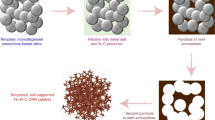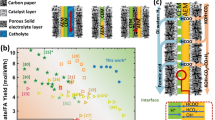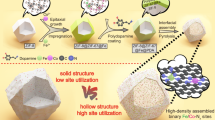Abstract
Rapid translation of catalysts from fundamental studies to high-performance devices could facilitate the development and commercialization of anion-exchange membrane fuel cells (AEMFCs). Traditionally, translation from material screening in three-electrode rotating disk electrode cells to AEMFCs is complicated by differences in microenvironments, for example, solid ionomer/membrane vs liquid electrolyte. Here we introduce a platform for translation to devices that utilizes ionomerless ultra-low-loading Ag–Pd alloy electrocatalyst cathodes synthesized by co-physical vapour deposition. Our ionomerless cathodes allow for systematic H2–O2 AEMFC experiments while demonstrating comparable activity trends to those in three-electrode cells. Furthermore, we show that our Ag10Pd90-based AEMFC reaches a peak power density of ∼1 W \({\rm{cm}}_{\rm{geo}}^{-2}\) (geometric area basis) and ∼10 W \({\rm{mg}}_{\rm{PGM}\; \rm{Cathode}}^{-1}\), satisfying the US Department of Energy’s platinum group metal (PGM) loading and cost targets. Our approach shows promise in facilitating the rapid translation between three-electrode studies and AEMFCs, offering a simple and effective design for decreasing PGM loadings.
This is a preview of subscription content, access via your institution
Access options
Access Nature and 54 other Nature Portfolio journals
Get Nature+, our best-value online-access subscription
$29.99 / 30 days
cancel any time
Subscribe to this journal
Receive 12 digital issues and online access to articles
$119.00 per year
only $9.92 per issue
Buy this article
- Purchase on Springer Link
- Instant access to full article PDF
Prices may be subject to local taxes which are calculated during checkout





Similar content being viewed by others
Data availability
All raw data plotted in this work can be accessed via Figshare (https://doi.org/10.6084/m9.figshare.22141169)47. Source data are provided with this paper.
References
Yue, M. et al. Hydrogen energy systems: a critical review of technologies, applications, trends and challenges. Renew. Sustain. Energy Rev. 146, 111180 (2021).
Staffell, I. et al. The role of hydrogen and fuel cells in the global energy system. Energy Environ. Sci. 12, 463–491 (2019).
Blizanac, B. B., Ross, P. N. & Markovic, N. M. Oxygen electroreduction on Ag(111): the pH effect. Electrochim. Acta 52, 2264–2271 (2007).
Kelly, S. R., Kirk, C., Chan, K. & Nørskov, J. K. Electric field effects in oxygen reduction kinetics: rationalizing pH dependence at the Pt(111), Au(111), and Au(100) electrodes. J. Phys. Chem. C. 124, 14581–14591 (2020).
Zamora Zeledón, J. A. et al. Tuning the electronic structure of Ag-Pd alloys to enhance performance for alkaline oxygen reduction. Nat. Commun. 12, 620 (2021).
Gottesfeld, S. et al. Anion exchange membrane fuel cells: current status and remaining challenges. J. Power Sources 375, 170–184 (2018).
Dekel, D. R. Review of cell performance in anion exchange membrane fuel cells. J. Power Sources 375, 158–169 (2018).
Thompson, S. T. & Papageorgopoulos, D. Platinum group metal-free catalysts boost cost competitiveness of fuel cell vehicles. Nat. Catal. 2, 558–561 (2019).
Ul Hassan, N. et al. Achieving high-performance and 2,000 h stability in anion exchange membrane fuel cells by manipulating ionomer properties and electrode optimization. Adv. Energy Mater. 10, 2001986 (2020).
Mustain, W. E., Chatenet, M., Page, M. & Kim, Y. S. Durability challenges of anion exchange membrane fuel cells. Energy Environ. Sci. 13, 2805–2838 (2020).
Kim, S. & Sung, Y.-E. Addressing a basic issue. Nat. Energy 6, 779–780 (2021).
Fan, J. et al. Bridging the gap between highly active oxygen reduction reaction catalysts and effective catalyst layers for proton exchange membrane fuel cells. Nat. Energy 6, 475–486 (2021).
Kamat, G. A. et al. Acid anion electrolyte effects on platinum for oxygen and hydrogen electrocatalysis. Commun. Chem. 5, 20 (2022).
Zamora Zeledón, J. A. et al. Probing the effects of acid electrolyte anions on electrocatalyst activity and selectivity for the oxygen reduction reaction. ChemElectroChem 8, 2467–2478 (2021).
Zamora Zeledón, J. A. et al. Engineering metal–metal oxide surfaces for high-performance oxygen reduction on Ag–Mn electrocatalysts. Energy Environ. Sci. 15, 1611–1629 (2022).
Singh, R. K., Devivaraprasad, R., Kar, T., Chakraborty, A. & Neergat, M. Electrochemical impedance spectroscopy of oxygen reduction reaction (ORR) in a rotating disk electrode configuration: effect of ionomer content and carbon-support. J. Electrochem. Soc. 162, F489–F498 (2015).
Lilloja, J. et al. Transition-metal- and nitrogen-doped carbide-derived carbon/carbon nanotube composites as cathode catalysts for anion-exchange membrane fuel cells. ACS Catal. 11, 1920–1931 (2021).
Wang, Y. et al. Synergistic Mn–Co catalyst outperforms Pt on high-rate oxygen reduction for alkaline polymer electrolyte fuel cells. Nat. Commun. 10, 1506 (2019).
Lazaridis, T., Stühmeier, B. M., Gasteiger, H. A. & El-Sayed, H. A. Capabilities and limitations of rotating disk electrodes versus membrane electrode assemblies in the investigation of electrocatalysts. Nat. Catal. 5, 363–373 (2022).
Zhang, J. et al. Recent insights on catalyst layers for anion exchange membrane fuel cells. Adv. Sci. 8, 2100284 (2021).
Berlinger, S. A. et al. Impact of dispersion solvent on ionomer thin films and membranes. ACS Appl. Polym. Mater. 2, 5824–5834 (2020).
Kodama, K. et al. Effect of the side-chain structure of perfluoro-sulfonic acid ionomers on the oxygen reduction reaction on the surface of Pt. ACS Catal. 8, 694–700 (2018).
Hickner, M. A. & Pivovar, B. S. The chemical and structural nature of proton exchange membrane fuel cell properties. Fuel Cells 5, 213–229 (2005).
Chaveanghong, S. et al. Sulfur poisoning of Pt and PtCo anode and cathode catalysts in polymer electrolyte fuel cells studied by operando near ambient pressure hard X-ray photoelectron spectroscopy. Phys. Chem. Chem. Phys. 23, 3866–3873 (2021).
Sharma, R. & Andersen, S. M. Zoom in catalyst/ionomer interface in polymer electrolyte membrane fuel cell electrodes: impact of catalyst/ionomer dispersion media/solvent. ACS Appl. Mater. Interfaces 10, 38125–38133 (2018).
Shinozaki, K., Morimoto, Y., Pivovar, B. S. & Kocha, S. S. Suppression of oxygen reduction reaction activity on Pt-based electrocatalysts from ionomer incorporation. J. Power Sources 325, 745–751 (2016).
Setzler, B. P., Zhuang, Z., Wittkopf, J. A. & Yan, Y. Activity targets for nanostructured platinum-group-metal-free catalysts in hydroxide exchange membrane fuel cells. Nat. Nanotechnol. 11, 1020–1025 (2016).
Thompson, S. T., Peterson, D., Ho, D. & Papageorgopoulos, D. Perspective—the next decade of AEMFCs: near-term targets to accelerate applied R&D. J. Electrochem. Soc. 167, 084514 (2020).
Hydrogen and Fuel Cell Technologies Office DOE Technical Targets for Polymer Electrolyte Membrane Fuel Cell Components (US DOE, 2022); https://www.energy.gov/eere/fuelcells/doe-technical-targets-polymer-electrolyte-membrane-fuel-cell-components
Pivovar, B. Catalysts for fuel cell transportation and hydrogen related uses. Nat. Catal. 2, 562–565 (2019).
Wang, X. X., Swihart, M. T. & Wu, G. Achievements, challenges and perspectives on cathode catalysts in proton exchange membrane fuel cells for transportation. Nat. Catal. 2, 578–589 (2019).
Omasta, T. J. et al. Beyond catalysis and membranes: visualizing and solving the challenge of electrode water accumulation and flooding in AEMFCs. Energy Environ. Sci. 11, 551–558 (2018).
Douglin, J. C., Varcoe, J. R. & Dekel, D. R. A high-temperature anion-exchange membrane fuel cell. J. Power Sources Adv. 5, 100023 (2020).
Douglin, J. C. et al. A high-temperature anion-exchange membrane fuel cell with a critical raw material-free cathode. Chem. Eng. J. Adv. 8, 100153 (2021).
Yassin, K., Rasin, I. G., Brandon, S. & Dekel, D. R. Quantifying the critical effect of water diffusivity in anion exchange membranes for fuel cell applications. J. Membr. Sci. 608, 118206 (2020).
Alty, T. X. The maximum rate of evaporation of water. Lond. Edinb. Dublin Philos. Mag. J. Sci. 15, 82–103 (1933).
Wang, T. et al. High-performance hydroxide exchange membrane fuel cells through optimization of relative humidity, backpressure and catalyst selection. J. Electrochem. Soc. 166, F3305–F3310 (2019).
Wang, L., Bellini, M., Miller, H. A. & Varcoe, J. R. A high conductivity ultrathin anion-exchange membrane with 500+ h alkali stability for use in alkaline membrane fuel cells that can achieve 2 W cm−2 at 80 °C. J. Mater. Chem. A 6, 15404–15412 (2018).
Yassin, K. et al. The effect of membrane thickness on AEMFC Performance: an integrated theoretical and experimental study. Energy Convers. Manage. 270, 116203 (2022).
Yassin, K., Rasin, I. G., Brandon, S. & Dekel, D. R. Elucidating the role of anion-exchange ionomer conductivity within the cathode catalytic layer of anion-exchange membrane fuel cells. J. Power Sources 524, 231083 (2022).
Nandan, R., Bisen, O. Y. & Nanda, K. K. The untold tale of the ORR polarization curve. J. Phys. Chem. C. 125, 10378–10385 (2021).
Bard, A. J. & Faulkner, L. R. Electochemical Methods: Fundamentals and Applications 2nd edn (Wiley, 2000).
Kjartansdóttir, C., Caspersen, M., Egelund, S. & Møller, P. Electrochemical investigation of surface area effects on PVD Al-Ni as electrocatalyst for alkaline water electrolysis. Electrochim. Acta 142, 324–335 (2014).
Higgins, D. et al. Copper silver thin films with metastable miscibility for oxygen reduction electrocatalysis in alkaline electrolytes. ACS Appl. Energy Mater. 1, 1990–1999 (2018).
Diesendruck, C. E. & Dekel, D. R. Water—a key parameter in the stability of anion exchange membrane fuel cells. Curr. Opin. Electrochem. 9, 173–178 (2018).
Douglin, J. C. et al. Quantifying the resistive losses of the catalytic layers in anion‐exchange membrane fuel cells. ChemSusChem https://doi.org/10.1002/cssc.202301080 (2023).
Douglin, J. C. et al. High performance ionomerless-cathode anion exchange membrane fuel cells with ultra-low loading Ag-Pd alloy electrocatalysts. Figshare https://doi.org/10.6084/m9.figshare.22141169 (2023).
Wang, Y. et al. Pt–Ru catalyzed hydrogen oxidation in alkaline media: oxophilic effect or electronic effect? Energy Environ. Sci. 8, 177–181 (2015).
Mandal, M. et al. The importance of water transport in high conductivity and high-power alkaline fuel cells. J. Electrochem. Soc. 167, 054501 (2019).
Cha, M. S. et al. Oligomeric chain extender-derived anion conducting membrane materials with poly(p-phenylene)-based architecture for fuel cells and water electrolyzers. J. Mater. Chem. A 10, 9693–9706 (2022).
He, C., Yang-Neyerlin, A. C. & Pivovar, B. S. Probing anion exchange membrane fuel cell cathodes by varying electrocatalysts and electrode processing. J. Electrochem. Soc. 169, 024507 (2022).
Peng, X., Omasta, T. J., Roller, J. M. & Mustain, W. E. Highly active and durable Pd–Cu catalysts for oxygen reduction in alkaline exchange membrane fuel cells. Front. Energy 11, 299–309 (2017).
Omasta, T. J. et al. Beyond 1.0 W cm−2performance without platinum: the beginning of a new era in anion exchange membrane fuel cells. J. Electrochem. Soc. 165, J3039–J3044 (2018).
Maurya, S. et al. Surface adsorption affects the performance of alkaline anion-exchange membrane fuel cells. ACS Catal. 8, 9429–9439 (2018).
Acknowledgements
Fuel cell testing and anode optimization work were partially funded by the Nancy and Stephen Grand Technion Energy Program (GTEP) to R.K.S. and D.R.D.; the Israel Science Foundation (ISF) (grant number 1481/17) to D.R.D.; the Russell Berrie Nanotechnology Institute, Technion to D.R.D.; the Ministry of National Infrastructure, Energy and Water Resources of Israel (grant number 3-17591 (220-11-040)) to D.R.D.; the Planning and Budgeting Committee/ISRAEL Council for Higher Education (CHE) and Fuel Choice Initiative (Prime Minister’s Office of ISRAEL), within the framework of ‘Israel National Research Center for Electrochemical Propulsion (INREP)’ to D.R.D. Cathode GDE materials and characterization were supported by the Toyota Research Institute (J.A.Z.Z., M.E.K, M.B.S., T.F.J.). Thin film synthesis efforts and anode characterization were supported by the US Department of Energy, Office of Science, Office of Basic Energy Sciences, Chemical Sciences, Geosciences and Biosciences Division, Catalysis Science Program to the SUNCAT Center for Interface Science and Catalysis (J.A.Z.Z., M.B.S., T.F.J.). Part of this work was performed at the Stanford Nano Shared Facilities (SNSF), supported by the National Science Foundation under award ECCS-1542152. J.C.D. personally wishes to thank I. and J. Jacobs and the Israeli Smart Transportation Research Center for their generous financial support in the forms of the Jacobs Fellowship and ISTRC Scholarship, respectively. J.A.Z.Z. gratefully acknowledges support of the Gates Millennium Graduate Fellowship/Scholarship.
Author information
Authors and Affiliations
Contributions
Conceptualization by J.C.D., J.A.Z.Z., M.B.S., T.F.J. and D.R.D.; data collection by J.C.D., J.A.Z.Z. and M.E.K.; data analysis by J.C.D., J.A.Z.Z., M.E.K., R.K.S., M.B.S., T.F.J. and D.R.D.; writing—original draft by J.C.D., J.A.Z.Z.; writing—review, editing and approval of final version by J.C.D., J.A.Z.Z., M.E.K., R.K.S., M.B.S., T.F.J. and D.R.D.; funding acquisition by T.F.J. and D.R.D.; supervision by M.B.S., T.F.J. and D.R.D.
Corresponding authors
Ethics declarations
Competing interests
The authors declare no competing interests.
Peer review
Peer review information
Nature Energy thanks Hui Li and the other, anonymous, reviewer(s) for their contribution to the peer review of this work.
Additional information
Publisher’s note Springer Nature remains neutral with regard to jurisdictional claims in published maps and institutional affiliations.
Supplementary information
Supplementary Information
Supplementary Figs. 1–9, Tables 1–9 and Notes 1–8.
Source data
Source Data Fig. 2
Raw data for plots in an Excel table.
Source Data Fig. 3
Raw data for plots in an Excel table.
Source Data Fig. 4
Raw data for plots in an Excel table.
Source Data Fig. 5
Raw data for plots in an Excel table.
Rights and permissions
Springer Nature or its licensor (e.g. a society or other partner) holds exclusive rights to this article under a publishing agreement with the author(s) or other rightsholder(s); author self-archiving of the accepted manuscript version of this article is solely governed by the terms of such publishing agreement and applicable law.
About this article
Cite this article
Douglin, J.C., Zamora Zeledón, J.A., Kreider, M.E. et al. High-performance ionomerless cathode anion-exchange membrane fuel cells with ultra-low-loading Ag–Pd alloy electrocatalysts. Nat Energy 8, 1262–1272 (2023). https://doi.org/10.1038/s41560-023-01385-7
Received:
Accepted:
Published:
Issue Date:
DOI: https://doi.org/10.1038/s41560-023-01385-7



